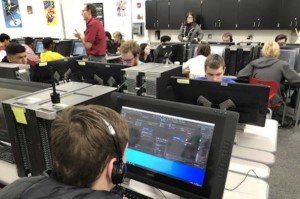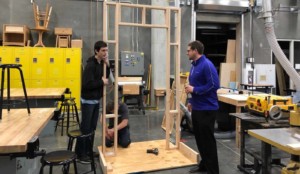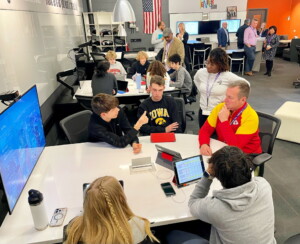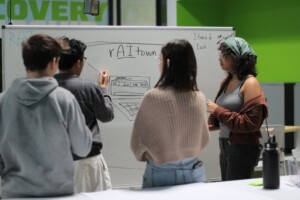What 100 School Visits Taught Us This Year

By: Tom Vander Ark and Emily Liebtag
We visited more than 100 schools this year. About half were new schools (in the last 20 years) and the other half were (at least partially) transformed. Most are good early next-gen examples of personalized and competency-based learning. They were in every corner of the country and ranged from tiny rural schools in Idaho to big schools in Chicago (and a few in Europe and Asia). As a year-end reflection, we identified 10 lessons.
Culture is the cumulative effect of stated and shared values, policies and structures, incentives and supports, and formal and informal communication. A productive culture is always the product of adults being very intentional about what they want the ethos of the school to be.
2. Students are known and cared for. Building on an intentional culture, great schools have practices and structures that make sure every student feels known and cared for. Knowing students—who they are, where they come from, what challenges they face, what opportunities they bring—can take learning to the next level.
At Thrive Public Schools, educators make sure every student is acknowledged and addressed individually every morning. Beyond the initial greeting each day, these educators know the daily goals and challenges students face and serve as both facilitators as well as mentors for their learning pathways.
The Singapore American School faculty visited 100 schools to learn that great schools have a culture of excellence, possibility, and care. School visits helped them benchmark and then innovative in all three areas.
3. Foundational ideas. Every good school is based on a set of foundational ideas that form a common intellectual mission (as Larry Rosenstock would say). This creates a common sense of purpose and focus. The mission should be both succinct and profoundly deep (you can summarize in 5 seconds or unpack it for 5 hours).
And there’s not a magic formula. Some focus on themes, or a bargain (like early college or P-tech), or a job cluster (like robotics). Some focus on pedagogical frames or justice claims. The point is that all good schools stake a claim, they stand for something, they pick a lane and go hard.
We saw this kind of focus at Odyssey STEM Academy, a new Big Picture Learning and altSchool combination high school near Los Angeles.
To fuel their turnaround, the Grant Beacon Middle School team in Denver went long on personalized learning and character development.
4. Intentional about outcomes. Good schools are intentional about important student outcomes (not just test scores). The have a, “We are going to get you there” mindset.
ACE Leadership High in Albuquerque helps disconnected youth connect with high wage employment. Quest Early College in Houston helps almost all students graduate with an AA degree.
A growing number of schools, districts and networks are creating graduate profiles. Even elementary schools like Katherine Smith in San Jose have graduate profiles.
5. Structures support deep work. At many schools, it’s hard to do deep extended work. Good schools support deep work with schedules, systems, professional learning opportunities, and assessments.
We saw two great examples recently in Philadelphia. Everything at Science leadership Academy supports inquiry-based learning. Structures and schedules at Vaux Big Picture in support work-based learning.
6. Shared work. Moving from a compliant “turn it in” culture to a “good work is done here” culture requires making work public through exhibitions and student-led conference. All of the schools in the deeper learning network do this well. The 10 schools in Philadelphia’s Innovation Network stress public work.
Students who know that their work and voices will be seen and heard by their community and peers are infinitely more engaged than those who know their products, ideas and projects are going to die in a pile of papers. To learn more about public work see ShareYourLearning (@ShareYourLearning, #ShareYourLearning).
EXHIBITION PREP, TIPS & TALES:
1. It is CELEBRATORY.
2. It’s NOT for grading.
3. The student IS the Exhibition.
4. Paint all you want, but you’re not an ARTIST until you SHOW YOUR WORK.
Winter #Exhibition: Wed, Dec.19th, 5:30p @hightechhigh
PUBLIC IS WELCOME#deeperlearning #pbl pic.twitter.com/rReKKMnkaB— Dr. Kaleb Rashad (@kalebrashad) November 16, 2018
7. Talent matters. Good schools have talented teachers that learn together about a shared pedagogy and creating an environment of high expectations and high support.
Teachers at Summit Public Schools spend 40 days a year in professional learning with access to personalized and goal-driven resources and weekly opportunities to collaborate with job-alike colleagues across the network.
At Energy Institute High, students will have worked in 20 different groups, on 20 different projects, and given over 30 different presentations. That takes extensive teacher planning and learning about projects and content. “Our teachers collaborate with industry connections to support our projects,” said Jenna Moon.
8. Distributed Leadership. Good schools and systems identify and engage teacher leaders. Opportunity Culture, an initiative of Public Agenda, has engaged 225 schools in new staffing models that engage teacher leaders.
At Singapore American School, 160 of 400 faculty members are engaged in leadership roles. More than 100 staff members visited 100 schools on six continents to learn about best practices.
9. Learning environments matter. The big trend of 2018 appears to be widespread recognition that learning environments matter.
When and where people have the opportunity we’re seeing more schools follow Larry Rosenstock advice on “height, light and exposed structure” in learning spaces.
And inside learning environments we’re seeing more flexible seating options–high and low, hard and soft, individual and group.
Q3. What would happen if you no longer told students where, how, or if to sit? Where, how, or if to work? Could that work? How would you need to prepare yourself? #rethink_learning @TimelessLrng pic.twitter.com/p7rJtGOKWr
— pammoran (@pammoran) November 27, 2018
In her dozen years as superintendent of Albemarle County Public Schools, Pam Moran (@pammoran) became an advocate for rethinking learning spaces. Flexible seating encourages student choice in the learning environment encouraging students to manage their own learning.
 10. Partnerships. Good schools rely on partners to expand their offerings and supports.
10. Partnerships. Good schools rely on partners to expand their offerings and supports.
Purdue Polytech in Indianapolis partners with Purdue University on STEM instruction and dual enrollment.
Starting with two schools managed under contract, Building 21 is expanding a membership network of schools that share their outcome framework, project-based learning model, and support systems.
Vaux Big Picture, partnered with the Philadelphia Housing Authority to refurbish an old school and make it the center a community redevelopment effort. Students participate in internships supported by the business community. Community groups provide youth and family support.
Key Takeaways:
[1:27] Emily elaborates on why she believes school visits are so key to professional learning.
[1:58] Emily summarizes what Getting Smart looks for in school visits.
[3:25] Emily kicks off the first of 10 lessons learned: culture is key.
[6:09] The second important lesson: students are known and cared for.
[8:14] Lesson number three: great schools have a foundational set of ideas.
[11:50] Lesson four: getting really intentional about outcomes.
[14:36] Lesson five: it’s important that the structures support deep work.
[16:36] Lesson six: shared, public work.
[19:38] Lesson seven: talent matters.
[22:02] Lesson eight: distribute and broaden leadership roles.
[23:59] Lesson nine: learning environments matter.
[26:28] Lesson ten: establishing partnerships is key.
[28:34] Emily and Tom reflect on their top ten list and wrap up this week’s episode.
Mentioned in this Episode:
100+ Middle and High Schools Worth Visiting
70 Elementary Schools Worth Visiting
Science Leadership Academy
Thrive Public Schools
High Tech High
Learner-Centered Innovation: Spark Curiosity, Ignite Passion and Unleash Genius, by Dr. Katie Martin
Portrait of a Graduate
Katherine R. Smith Elementary School
Big Picture Philadelphia
The Workshop School
Share Your Learning
@ShareYourLearn
Singapore American School
Opportunity Culture
Envision City Arts and Tech School
Sarah E. Goode STEM Academy
Purdue Polytechnic Institute
XQ Super School
Who You Know: Unlocking Innovations That Expand Students’ Networks, by Julie Freeland Fishe
For more on school visits, see:
- 15 School Districts Worth Visiting
- 100 Middle and High Schools Worth Visiting
- 70 Elementary and Middle Schools Worth Visiting
Stay in-the-know with all things EdTech and innovations in learning by signing up to receive the weekly Smart Update. This post includes mentions of a Getting Smart partner. For a full list of partners, affiliate organizations and all other disclosures please see our Partner page.









0 Comments
Leave a Comment
Your email address will not be published. All fields are required.